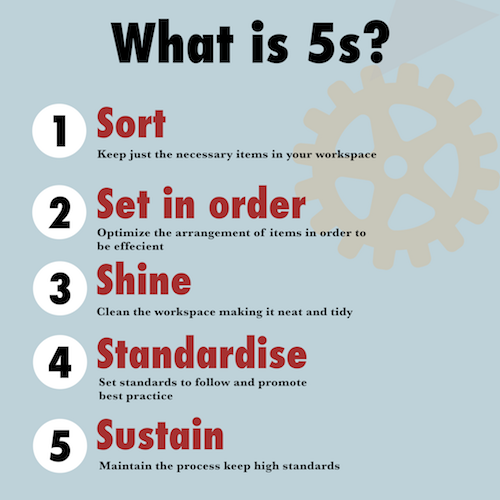If like me, you sometimes look around your business environment and think that it’s disorganized and inefficient it’s maybe time to do something about it!
There are a number of proven improvement techniques used to optimize your working environment and one of the most common is 5s.
5s has its origins in lean manufacturing and it provides a fundamental initial step in many continuous improvement plans.
5s is an important tool as it helps delivers efficiencies such as removing waste and enabling effectiveness. One of the associated benefits is that it’s a team game and can involve all workers from the targeted area fostering a team spirit and collective focus on improvement.
5s events are usually established to target a particular process or section of the business, deployment of the tool is usually called a 5s event.
The good news is that 5s isn’t complicated and while simple it’s very powerful in enabling business transformation.

What is 5s?
OK let’s start with the basics. The origins of 5s come from Japan and the 5 s’s in this instance related to the Japanese words seiri, seiton, seiso, seiketsu, and shitsuke. These words related to establishing an organized working environment. Over the years these 5’s have been “anglicised” to
* Sort – review the workspace and remove unnecessary items and equipment (your only left with what you need)
* Set in order – Assign positions for your equipment that you kept during your “sort” phase
* Shine – clean your work area!!
* Standardize – Look to Standardize best practices across the workplace, set standards and keep to them.
* Sustain – don’t retreat into old habits – maintain the new optimized process – everything in its place and a place for everything.
Implementing 5s.
As we stated above – 5s is usually run as an event where the workforce gets together to optimize a particular area. These events are usually run by experienced lean practitioners (often part of the Quality function within a business). The workforce is usually told of the event a few weeks leading up to it so they can prepare and a designated area is set aside (usually referred to as a red tag area) to place items for review (as part of the sort element).
Of course, the key objective of 5s is efficiency and effectiveness – you’re not just doing the 5s event for fun you want to see benefits so it comes as no surprise that one of the fundamental steps is to establish a target as part of the activity – perhaps something’s going wrong in that area that you want to improve, perhaps efficiency is not what it should – whatever the issue make sure you understand the current performance and set yourself a post-event performance target so you can monitor the effectiveness of your 5s events.
Without a doubt, 5s events can bring the workforce together in a fun way. They can challenge the status quo and allow everyone a voice.
The most challenging element of 5s is often the latter part – sustain – old habits can be difficult to eradicate and without proper sustainment techniques you can, unfortunately, see benefits being short-lived. That’s why many companies put in place 5s champions to continuously drive the improvements.
Remember, 5s is a tool and is only as good as its implementation, it needs time to succeed coupled with a willing workforce but if executed well can reap rewards.
Got some 5s tips and tricks? Let us know about them in the comments section below.